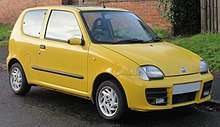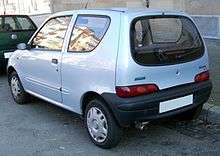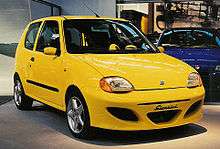Fiat Seicento
The Fiat Seicento (Type 187) was a city car produced by the Italian company Fiat, introduced at the end of 1997 as a replacement for the Fiat Cinquecento, although it was also based on the Cinquecento. The Seicento did not differ much from its predecessor, retaining the same engines, chassis and general dimensions, although it did gain a minor 90 mm in length (total length of 3,340 mm).
| Fiat Seicento (1998-2005) Fiat 600 (2005-2010) | |
|---|---|
| Overview | |
| Manufacturer | Fiat Auto (1998-2007) Fiat Group Automobiles (2007-2010) |
| Also called | Fiat 600 |
| Production | 1998–2010 (1,328,839 units) |
| Assembly | Tychy, Poland |
| Body and chassis | |
| Class | City car (A) |
| Body style | 3-door hatchback |
| Layout | Front-engine, front-wheel-drive |
| Related | Fiat Cinquecento |
| Powertrain | |
| Engine | 900 cc (55 cu in) I4 (petrol) 1.1 L I4 (petrol) 30 kW/40 hp (electric) |
| Transmission | 5-speed manual 5-speed semi-automatic |
| Dimensions | |
| Wheelbase | 2,200 mm (86.6 in) |
| Length | 3,337 mm (131.4 in) |
| Width | 1,508 mm (59.4 in) |
| Height | 1,420 mm (55.9 in) |
| Curb weight | 710–750 kg (1,570–1,650 lb) |
| Chronology | |
| Predecessor | Fiat Cinquecento |
| Successor | Fiat Nuova 500 Fiat Panda (169) |
Like its predecessors, the Cinquecento and Polski Fiat 126, the Seicento was built in Fiat's factory in Tychy, Poland.[1]
From March 1998 to April 2004, 1.1 million examples of the Seicento had been produced.[2] The Seicento name comes from the Italian word for 600; the Seicento is the spiritual successor to the Fiat 600. The car was rebadged as the 600 to celebrate the 50th anniversary of the original model.
EuroNCAP performance
In EuroNCAP crash tests, the Fiat Seicento was only awarded a 1.5 star rating, and fractionally beat the worst contenders in the history of EuroNCAP, namely the Rover 100 (a restyled Rover Metro, in turn directly based on the Austin Metro) and the original Chrysler Voyager MPV.[3]
This is not so surprising, as the car has an extremely short front end and keeps many components from its predecessor, originally conceived in the end of 1991. In comparison, another small car, the Smart Fortwo (which has a shorter front end), earned three stars in the crash test. These cars started production in 1997, and are not designed for EuroNCAP tests, which commenced in 1997.
Versions
Trims/Equipment


At launch, the Seicento was available with three trim levels; a basic 'S' with black bumpers and spartan equipment and initially the 899 cc 29 kW (39 hp) FIAT 100 series engine; the 'SX', which was a slight upgrade over the 'S' and included colour coded bumpers, electric windows, central locking and a sunroof. The 'SX' was also available as a 'Citymatic' which features clutchless manual gearchange, and a 'Sporting' with the larger FIAT FIRE series 1,108 cc 40 kW (54 hp) engine, 20 mm (0.8 in) lower suspension and anti roll bars added.
Cosmetically, this version gained 13" alloy wheels and sports seats. An Abarth styling kit was also available consisting of a body kit with optional Abarth 14" wheels. A close ratio gearbox, sill kick plates, embroidered headrests, leather gear lever and steering wheel, colour highlighted trim in the bumpers, side skirts and a spoiler also available.
Both the 'Sporting' and the Abarths were available with ABS, air conditioning and power steering, but due to cost, not very many owners took up the options.
In 1999, the FIRE engine was used in the special 'Suite' version, which came with air conditioning. A special edition called the 'Soleil' was available in some markets, which was based on the 'SX' model, but came with a full length electrically folding fabric roof.
In October 2000, after the update, all cars were given clear indicator lenses, with the Sporting model getting a restyled bodykit. Power steering was still optional on lower end Seicentos.
A 'Michael Schumacher' edition of the Sporting, with ABS and the Abarth styling kit, was also launched at this time to celebrate the Ferrari driver's Formula One success. This model was almost identical to the 'Sporting' with the Abarth kit with the exception of a chrome gear lever surrounds and Michael's signature on the boot lid and side skirt. A limited edition plate and number was located on the passenger door.
The model was officially withdrawn from the market in the United Kingdom in 2004, and production of right hand drive models ceased, following the arrival of the new and more practical Panda.[4] The left hand drive model was facelifted, gaining a new design for the wheels, and the introduction of the new Fiat logo to the rear.
Fiat 600
In 2005, the name Seicento was replaced by 600 (in celebration of the 50th anniversary of the first edition, in 1955) together with some changes to the front fascia and in the interior with the name Fiat now written on the seats. The new versions now are named "Class" and "50th Anniversary", denoting the strict relationship between this model and the previous one.
Engines
The Seicento was available with two engines: the old 899 cc Overhead valve 29 kW (39 hp) engine used in early base S and SX models (which was removed from West European markets due to emissions regulations), and the 1,108 cc FIRE 40 kW (54 hp) and used in the Sporting version since launch). Both used single point injection.
The latter was fitted universally with multi point fuel injection from 2001, replacing the old 899 cc unit due to the tightening emission regulations. There was also a version with an electric engine 30 kW (40 hp).
Elettra
Until 2005, Fiat also produced a battery-electric version of the Seicento called the Seicento Elettra. Originally produced in serial quantities in Italy from 1996 to 1998, production moved to Poland for the remaining years where it was built to order. The Seicento Elettra featured a 30 kW three-phase asynchronous electric motor powered by eighteen 12V lead-acid batteries in the engine bay and beneath the rear seats.
The Seicento Elettra's top speed was 100 km/h (62 mph) and its range was 90 kilometres (56 mi).[5]
Tuning

German tuner Novitec created a special edition of the Fiat Seicento, adding a turbocharger and six speed gearbox to the little car. The German tuner is able to extract 74 kW (99 hp) from the 1,108 cc FIRE engine. Other tuners include the venerable Giannini company, who produced an aggressive bodykit and also considered installing a 1.6 litre engine.
Future replacement
The car ceased production in 2010. Although no direct replacement was announced, much of the market territory it once occupied had already been filled by the new Fiat Panda (2003) and the 500 (2007), as well as the budget model Fiat Palio.
References
- "Main Fiat group automobile plants in the World". Fiat Group. Archived from the original on 27 September 2007. Retrieved 10 July 2007.
- "New Fiat Seicento". Fiat. April 2004. Archived from the original on 28 March 2009.
One million one hundred thousand Fiat Seicento have rolled off the production line since 1998.
- "Fiat Seicento". euroncap.com. Retrieved 10 July 2007.
- "Fiat Seicento". Channel 4. Archived from the original on 22 June 2008. Retrieved 5 June 2008.
- "Elektromobil FIAT Seicento Elettra" (in Czech). Archived from the original on 20 March 2012. Retrieved 23 October 2011.